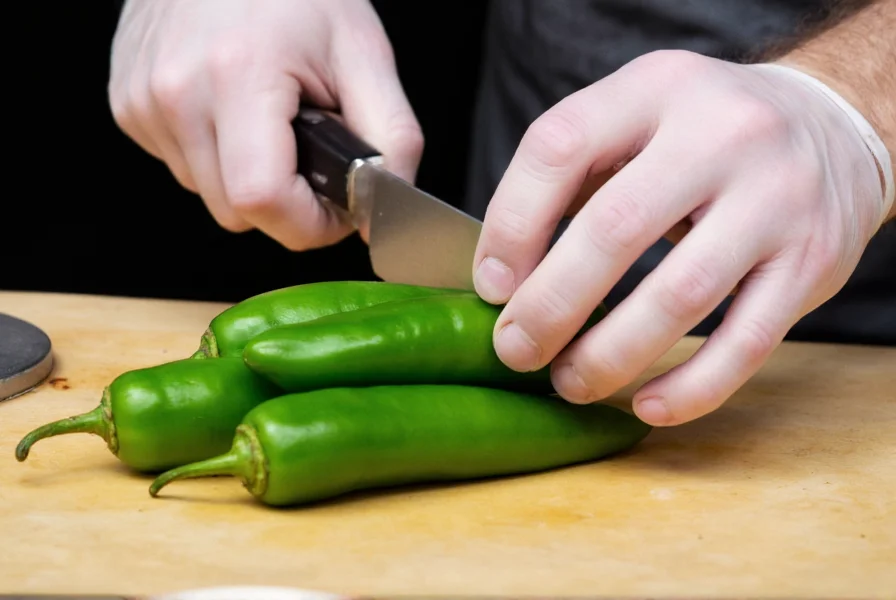Understanding where serrano peppers fall on the spice spectrum is essential for both home cooks and culinary professionals. These vibrant green or red peppers deliver a clean, grassy heat that's become increasingly popular in Mexican cuisine and beyond. Unlike some chili varieties, serranos maintain consistent heat levels across different growing conditions, though environmental factors can influence their final Scoville rating.
Decoding the Scoville Scale for Serrano Peppers
The Scoville scale, developed by pharmacist Wilbur Scoville in 1912, measures capsaicin concentration—the compound responsible for chili heat. Modern testing uses high-performance liquid chromatography for precise measurements, but the Scoville Heat Unit (SHU) remains the standard reference.
Serrano peppers occupy a distinctive position between common supermarket peppers and intensely hot varieties. Their heat registers at 10,000-23,000 SHU, making them approximately 2-5 times hotter than jalapeños (2,500-8,000 SHU) but substantially milder than habaneros (100,000-350,000 SHU). This intermediate heat level provides culinary versatility that explains their growing popularity in salsas, sauces, and fresh preparations.
| Pepper Variety | Scoville Heat Units | Heat Comparison to Serrano |
|---|---|---|
| Bell Pepper | 0 SHU | 0 times |
| Jalapeño | 2,500-8,000 SHU | ⅓ to ⅘ times |
| Serrano | 10,000-23,000 SHU | 1 times |
| Cayenne | 30,000-50,000 SHU | 1.5-2 times |
| Habanero | 100,000-350,000 SHU | 5-15 times |
Factors Influencing Serrano Pepper Heat Levels
Several elements affect where a specific serrano pepper falls within its 10,000-23,000 SHU range:
- Maturity: Riper red serranos often register higher on the Scoville scale than their green counterparts
- Growing conditions: Stressors like inconsistent watering or nutrient deficiencies can increase capsaicin production
- Plant genetics: Different serrano cultivars naturally produce varying heat levels
- Part of the pepper: The placenta (white ribs) contains the highest concentration of capsaicin
Unlike some chili varieties, serranos maintain relatively consistent heat profiles across different growing regions. This reliability makes them preferred by chefs who require predictable spice levels in their recipes—a key factor in their "serrano pepper heat consistency" advantage over more variable peppers like jalapeños.
Culinary Applications Based on Heat Profile
The distinctive heat profile of serrano peppers makes them ideal for specific culinary applications. Their clean, bright heat without overwhelming fruitiness allows them to enhance rather than dominate dishes. When considering "how hot are serrano peppers for cooking," remember these practical applications:
- Salsas and pico de gallo: Finely diced serranos add controlled heat without compromising fresh flavors
- Infused oils and vinegars: Their moderate heat transfers beautifully to liquids
- Marinades: The capsaicin helps tenderize proteins while adding dimension
- Garnishes: Thin slices provide visual appeal and precise heat bursts
For those exploring "serrano vs jalapeno heat comparison" in practical cooking terms, serranos deliver more immediate, sharper heat that dissipates faster than jalapeños' slower-building warmth. This characteristic makes serranos preferable when you want noticeable heat without prolonged mouth burn.

Safety Considerations for Different Heat Tolerances
Understanding "serrano pepper Scoville units range" is crucial for accommodating various heat tolerances. While not considered extremely hot, serranos can still overwhelm those unaccustomed to spicy foods. Consider these safety guidelines:
- Always wear gloves when handling serranos, especially when cutting multiple peppers
- Remove seeds and white membranes for milder heat—these contain the highest capsaicin concentration
- Start with half a pepper in recipes, then adjust to taste after cooking
- Have dairy products like yogurt or sour cream available to neutralize capsaicin if needed
For those wondering "are serrano peppers hotter than jalapenos," the answer is consistently yes—but the difference is manageable. Serranos provide a noticeable step up in heat while remaining accessible to most palates, making them an excellent transition pepper for those expanding their spice tolerance.
Practical Handling Tips for Maximum Flavor
To fully leverage the "serrano pepper heat profile for recipes," follow these professional techniques:
- Storage: Keep fresh serranos in a paper bag in the refrigerator crisper drawer for up to three weeks
- Preparation: Slice rather than dice to control heat distribution in dishes
- Heat management: Soak sliced serranos in lime juice for 10 minutes to slightly reduce heat while enhancing flavor
- Freezing: Whole frozen serranos maintain quality for up to six months and are easier to handle when partially thawed
When substituting serranos in recipes calling for other peppers, remember that one serrano typically equals 2-3 jalapeños in heat but delivers a different flavor profile. This "serrano pepper substitution guide" knowledge helps maintain recipe balance while adjusting spice levels.












 浙公网安备
33010002000092号
浙公网安备
33010002000092号 浙B2-20120091-4
浙B2-20120091-4